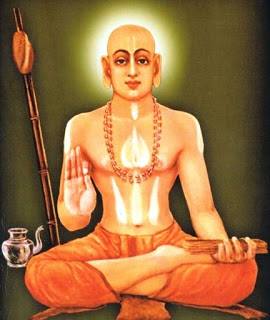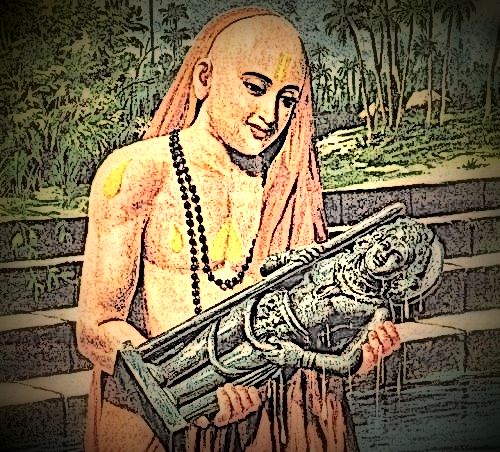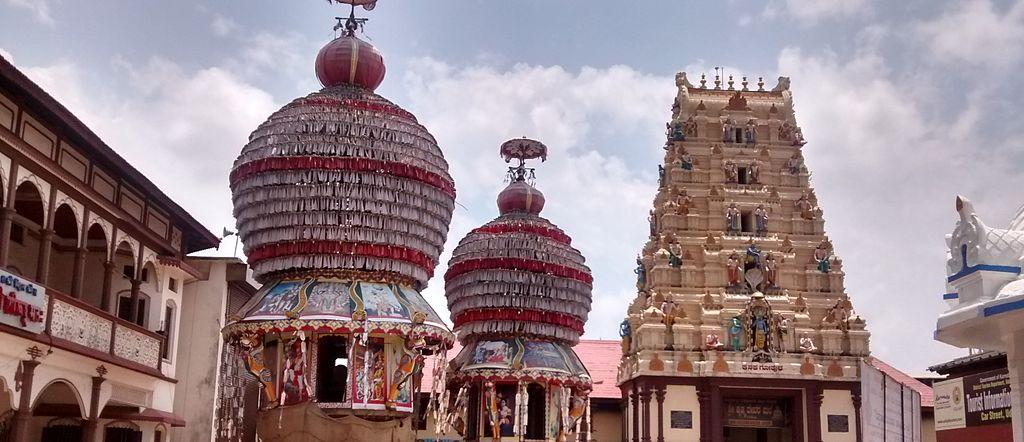
Nestled along the Arabian Sea in the picturesque state of Karnataka, South India, lies the sacred town of Udupi. This tranquil town has earned its fame primarily due to the divine presence of Sri Krishna Math (Sri Krishna Udupi Temple), which is of great reverence and spiritual significance. The origins of this hallowed temple trace back to the illustrious Srila Madhvacharya (A.D. 1238-1317), an eminent saint, philosopher, and religious reformer of India. Udupi, often described as Vaikuntha, the abode of Lord Vishnu, is believed to have achieved this exalted status because the deity of ‘Bala Krishna’ graced it with His presence in response to the pure devotion of Srila Madhvacharya.
The Divine Birth of Sri Madhvacharya: Reviving Pure Devotion in a Time of Decline
Narayana Bhatta, a devout Brahmana from the esteemed Madhyageha lineage, resided with his wife Vedavati at Pajaka Kshetra, near the Papanasini river on the southeast of Udupi Kshetra, Karnataka, South India. This sacred place holds significance as the site where Lord Parasurama created holy tirthas.
Over time, Narayana Bhatta and Vedavati were blessed with two sons, but tragically, both sons passed away prematurely. Left without offspring, the Brahmana couple embarked on twelve years of rigorous austerities, subsisting solely on milk, with a fervent desire for an immortal son. Their unwavering devotion touched the heart of the Supreme Lord, who was moved to reward them. During this period, the practice of pure devotional service was scarce in Bharata-Varsha, and Sanatana Dharma was in decline. Atheistic ideologies, exemplified by Buddhism, and the obscured philosophy of Shankaracharya’s Mayavada were leading people towards profound ignorance.

To rekindle the flame of Sanatana Dharma and restore the essence of pure devotional service, Vayu, the demigod of wind, manifested in the mortal realm as Sri Madhvacharya (Purnaprajna), by the divine will of Lord Vishnu. Just as Vayu had previously incarnated as Hanuman in Treta Yuga and as Bhima in Dvapara Yuga, he assumed the form of Sri Madhvacharya in the age of Kali. His birth, named Vasudeva, occurred on the auspicious day of Vijayadashami in the year 1238 AD, ushering in a new era of spiritual enlightenment.
The Pre-Madhva Era and the Twin Temples
Even before the advent of Srila Madhvacharya, Udupi had already garnered a reputation as a sacred destination. People from all corners of South India embarked on pilgrimages to Udupi, drawn by its status as a hub of Vedic scholarship and the presence of two ancient temples: Sri Ananteshvara and Sri Candramauleshvara. Among these, the Sri Anantheshwara temple stands out as the more renowned. It is believed that Lord Vishnu, along with His personal expansion Lord Ananta-shesha, resides within the Siva-linga, the deity form of Lord Siva. Lord Siva, the most potent demigod and an ardent devotee of Lord Vishnu (Krishna), is venerated here. The Sri Candramauleshvara temple, dedicated to Lord Shiva, derives its name from the crescent moon (candra) adorning his head. Before the era of Madhvacharya, Udupi was relatively obscure, except for its etymological connection with Lord Shiva, with “Udupi” being derived from “Udupa,” a name signifying “he who carries the moon on his head.”

The Era of Srila Madhvacharya and Sri Krishna Matha
Prior to establishing the Sri Krishna Matha, Srila Madhvacharya was closely associated with the Sri Anantheshwara temple. Here, he captivated audiences with erudite discourses on the science of Krishna consciousness. Within the temple precincts, Madhvacharya frequently engaged in debates with scholars who opposed pure devotion to Lord Krishna as the ultimate goal of Vedic knowledge. Remarkably, Madhvacharya never lost a debate. However, after founding the Sri Krishna Matha, he made it the epicenter of his activities. Tradition dictates that pilgrims first pay homage to Lord Shiva at Candramauleshvara, then to Lord Vishnu at Anantheshwara, before crossing the street to Sri Krishna Matha to worship Srila Madhvacharya’s original Deity of Lord Bala Krishna, the Supreme Lord in His childhood form.
The Miraculous Journey of Lord Bala Krishna
The incredible tale of how the Deity of Lord Bala Krishna traversed the ocean from distant Dvaraka in Northwest India to Udupi in the South is recounted in “Madhva-vijaya,” the biography of Srila Madhvacharya. Madhvacharya harbored a fervent desire to establish a temple of Lord Krishna in Udupi, allowing devotees to adore and serve the Lord while elevating their souls. In Dvaraka, one of the principal locales of Lord Krishna’s earthly pastimes five thousand years ago, an unidentified Deity lay concealed within a massive lump of gopi-candana clay. Unaware of the Deity’s presence, sailors loaded the clay lump onto their merchant ship as ballast during their southward journey. Off the coast of Udupi, a tempest stranded the ship on a sandbank.

On that very day, Srila Madhvacharya, engrossed in composing the “Dvadasha-stotra,” his renowned twelve-part poem extolling Lord Krishna, had gone to the beach either for a bath or to receive the Lord’s blessings. Upon witnessing the ship stranded on the sandbank and hearing the sailors’ distress calls, Madhvacharya waved his cloth in their direction. Miraculously, the turbulent seas subsided, and the ship was freed. Madhvacharya then guided the vessel to safety. In gratitude, the ship’s captain offered him anything from the cargo, and Madhvacharya chose the heavy lump of gopi-candana clay.
As Madhvacharya’s disciples began their journey back to Udupi with the massive clay lump, it broke in two, revealing the resplendent Deity of Lord Bala Krishna. Despite the combined efforts of thirty disciples, the Deity remained immovable until Madhvacharya personally embraced and lifted Him, reminiscent of a child. In an ecstatic state, Madhvacharya carried the Lord four miles back to Udupi, completing the remaining seven parts of the “Dvadasha-stotra” en route. In Udupi, Madhvacharya bathed the Lord in the sacred Madhva-sarovara lake and enshrined Him in the Sri Krishna Matha. Srila Madhvacharya instituted rigorous standards for Sri Krishna’s worship, personally performing the thirteen daily rituals for the Lord during his presence in Udupi.
The Origin of Bala Krishna Deity
The story of how the Deity of Bala Krishna came to be buried in Dvaraka is narrated in “Prameya-navamalika-tika,” a seventeenth-century work by Raghuvarya Tirtha, a successor of Srila Madhvacharya. During Lord Krishna’s earthly pastimes, Mother Devaki expressed her deep longing to witness the Lord’s childhood exploits in Vrindavana. Moved by her pure devotion, the Supreme Lord instantly assumed the form of a small child and playfully clambered onto Devaki’s lap. Subsequently, when Devaki attempted to churn butter, Krishna, behaving like a mischievous child, broke the churn, consumed chunks of butter, and smeared butter all over His transcendental body. He even seized the churning rod and rope from Devaki’s hands. These delightful childhood pastimes of the Lord filled Mother Devaki with immeasurable joy.
Queen Rukmini-devi, Lord Krishna’s consort, was a witness to these enchanting episodes. She was captivated by the Lord’s mischievous behavior and infantile features. To preserve the memory of these delightful moments, she had a Deity fashioned in the likeness of young Krishna holding a churning rod and rope. Queen Rukmini commenced the worship of this Deity with great devotion. After the Lord returned to the spiritual realm with His retinue, Arjuna placed the Deity in a location called Rukminivana. Over the centuries, the Deity became encased in clay, remaining in that state near Dwaraka until it was transported to Madhvacharya in Udupi by merchant sailors.
Continuation of the Legacy
Before departing from this earthly realm, Srila Madhvacharya appointed eight of his sannyasi disciples to oversee the worship at Sri Krishna Matha and propagate Krishna consciousness in the region. Presently, the responsibility for worship is rotated in two-year cycles known as “paryaya” among these eight sannyasis, who are part of the lineage initiated by Srila Madhvacharya. During the fourteen-year interval between paryaya shifts, each sannyasi travels, preaches, and raises funds for the temple’s upkeep. While in their respective paryaya periods, they personally conduct the thirteen daily rituals for the Deity.
Each sannyasi also presides over his own matha, where additional Deities, originally gifted by Madhvacharya to the initial eight sannyasis, are venerated. These eight mathas are situated along Car Street, a road encircling the Candramauleshvara and Anantheshwara temples and passing the primary entrance of Sri Krishna Matha. These eight mathas of Udupi are –
These eight Mathas (Ashta Mathas) are:
- Pejavara,
- Puttige,
- Palimaru Matha,
- Admaru Matha,
- Sodhe Matha,
- Kaniyoor Matha,
- Shirur Matha
- Krishnapura Matha
A Spectacle of Devotion: The Car Street Parades
Marked by a decorated elephant and a musical ensemble, parades along Car Street are nightly events in Udupi. Residents and pilgrims alike flock to witness the Lord riding high on His cart, bestowing benevolent smiles upon adoring devotees. The procession pauses at intervals along the route, where the Lord is entertained with fireworks displays and offerings from His numerous devotees. Commencing at eight in the evening, the parades typically conclude by nine-thirty.

The fervent devotion displayed by the people of Udupi warms the heart of any observer, even the most hardened non-devotee. Udupi remains one of the last bastions in India where devotional and spiritual traditions, for which India is renowned, continue to thrive. This pure devotional ambiance is a prominent hallmark of the spiritual realm. Thus, Udupi aptly earns the title of “the Kingdom of God on Earth.”
Srila Madhvacharya’s Teachings in a nutshell
The philosophical doctrine Srila Madhvacharya expounded is commonly known as Dvaita Vada or Tattva Vada. Below are his nine essential teachings –
- Lord Vishnu alone is the Supreme absolute truth.
- Lord Vishnu is the object of all Vedic knowledge.
- The material world is real.
- The living entities are separate from Lord Vishnu.
- The Living entities are servants of Lord Hari’s lotus feet.
- The Living entities are of two types – Liberated and Conditioned.
- Attainment of Lord Vishnu’s lotus feet alone is the liberation for the conditioned souls.
- Pure worship of Lord Vishnu is the cause of conditioned souls’ liberation.
- The three types of evidence are direct perception, hypothesis and the Vedas.